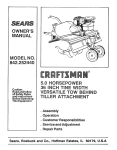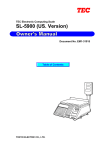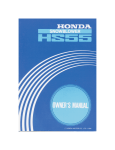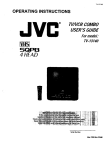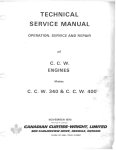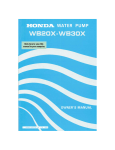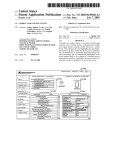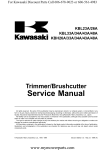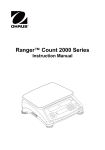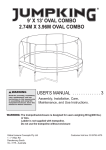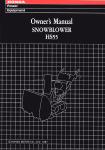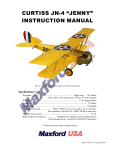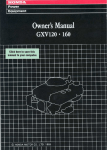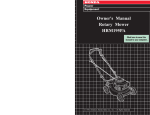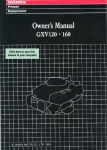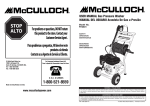Download Honda HT-R3811 User's Manual
Transcript
Thank you for purchasing a Honda riding mower. This manual covers the operation and maintenance riding mower, type SA (side discharge). of the Honda HT-R3811 Honda Motor Co., Ltd. reserves the right to make changes at any time without notice and without incurring any obligation. No part of this publication may be reproduced without written permission. This manual should be considered a permanent part of the riding mower and should remain with the riding mower when sold. Pay special attention to statements preceded by the following words; A DANGER: Indicates severe personal structions are not followed. injury or loss of life will result if in- M&m Indicates a strong possibility life if instructions are not followed. of severe personal injury CAUTION: instructions NOTE: l l Indicates a possibility are not followed. Gives helpful of personal injury or equipment or loss of damage if information. Honda riding mowers are designed to give safe and dependable service if operated according to instructions. Read and understand this Owner’s Manual before operating the riding mower. Failure to do so could result in personal injury or equipment damage. If a problem should arise, of if you have any questions consult an authorized Honda riding mower dealer. about the riding mower It is illegal in some areas to operate a gasoline engine without a U.S.D.A. qualified spark arrester; check local laws and regulations. You can purchase an optional spark arrester for this riding mower from your authorized Honda Power Equipment dealer. HONDA MOTOR CO., LTD. 1986, ALL RIGHTS RESERVED CONTENTS 1. 2. 3. 4. 5. 6. 7. 8. 9. 10. 11. 2 ........................................................... SAFETY INSTRUCTIONS COMPONENT IDENTIFICATION . ................ ................................. CONTROLS .............................................................................. PRE-OPERATION CHECKS ......................................................... .............................................................. OPERATION ................ l Starting the engine ............................................................... ............................................................................. l Mowing . Stopping the engine ............................................................. . High altitude operation ........................................................... ....................................................... TRANSPORTING/STORAGE MAINTENANCE ........................................................................ ................................................................ TROUBLESHOOTING ..................................................................... SPECIFICATIONS . ........... WIRING DIAGRAM ........................................................ WARRANTY SERVICE ............................................................... 3 7 10 15 23 23 26 30 31 32 38 55 58 59 60 1 m SAFETY INSTRUCTIONS WARNING LABEL LOCATIONS I PASSENGERS. GMAXIMUM SAFE OPERATING ANGLE 10 DEGREES. (17% GRADE) 10’MAX. #REDUCE SPEED WHEN TURNING OR OPERATING ON SLOPES. GSTOP ENGINE BEFORE REMOVING GRASS CATCHER OR CLEANING DISCHARGE CHUTE #KEEP ALL SHIELDS AND SAFETY DEVICES IN PLACE. GKEEP PEOPLE AND PETS AT A SAFE DISTANCE WHILE OPERATING. I RIDING MOWER SAFETY w Oberating a riding mower requires special efforts on your part to ensure your safety and the safety of others. Know these requirements before you operate the riding mower. SAFE OPERATING l l l l l l l l l l l RULES Always make a pre-operation inspection (page 15) before you operate the riding mower; you may prevent an accident or equipment damage. All parts, especially guards and shields, should be in good condition, and securely fastened in place. Be sure all nuts, bolts and screws are tight; especially the blade mounting bolts. Do not remove any guards, warning labels, shields or safety devices; they are installed for your safety. Know how to stop the engine and blades quickly. Thoroughly understand operation of all controls. Never permit anyone to operate the riding mower without proper instructions. Do not allow passengers to ride on the mower or any of its attachments. Children should not be permitted to operate this riding mower. Because of the danger of carbon monoxide poisoning, do not run the engine indoors. To prevent serious injury, never put your hands or feet under the cutter deck. Do not operate the riding mower while barefoot. Wear sturdy shoes or boots and clothing that is not loose. Be alert. Do not operate the riding mower when you are tired, ill or under the influence of alcohol or drugs. Mow only in daylight or good artificial light. Watch out for and avoid rocks, roots, holes and other obstacles. If you hit an object, stop and inspect the riding mower; fix any damage before you operate the mower again. Replace damaged, worn or broken parts immediately. Do not operate near the edge of a ditch or an embankment. l l l l l l BEFORE MOWING l l l l l Before mowing, always clear the lawn of stones, sticks and other debris. These objects could be thrown out by the spinning blades and cause an injury or equipment damage. Select a safe operating speed (gear position) for the area to be mowed. 5th gear should be used only while driving to and from the storage area. Always ensure that the area in front of and behind the riding mower is clear of people, pets and debris before starting. Be very careful when you operate the riding mower in Reverse. Do not mow in Reverse unless it is absolutely necessary. OPERATION l ON SLOPES This riding mower is intended for use on relatively flat terrain. Do not use on sloped surfaces exceeding 10 degrees (I 7% grade). This angle may be further reduced by the condition and type of surface. Maximum safe operating angle 0”MAX MAXIMUM IO” (17% GRADE) 5 l l l l l If mowing on a sloping surface, always drive up and down the face of the grade. Never turn or drive across the face of the slope. To prevent loss of control or overturning, always reduce speed and exercise extreme caution when operating on sloping or uneven surfaces. Avoid turning or stopping on sloping surfaces; see page 28 for special instructions. Do not back down or rapidly accelerate up a sloping surface; see page 28 for special instructions. When mowing on slopes, empty the grass bags when they are half full. On a slope, the weight of full bags may cause the mower to tip over. CLEANING l l l l l AND STORAGE Leaves, grass clippings, oil and other combustible materials can become a fire hazard. Be sure to keep the engine compartment, the upper cutter deck surfaces and the belt and pulley areas clean. Stop the engine before removing the grass bags or cleaning the discharge chute. Check the condition of the grass catcher bags frequently. For your safety, replace any bag that is worn or deteriorated. Always empty the grass catcher bags when mowing is completed. D,amp, decomposing grass clippings generate heat and can become a fire hazard. To reduce the possibility cool before storing materials. of fire, the mower allow the engine in an enclosed and exhaust system space or near combustible to 2. COMPONENT STEERING ENGINE IDENTIFICATION WHEEL SWITCH AIR INTAKE LEVER \ I DISCHARGE’CHUTE BRAKE‘ PEDAL \ WARNING BUZZER 7 POWER TAKE-OFF DECK HEIGHT ADJUSTING L CUTTER DECK / REAR Raise 8 BODY Engine compartment AIR CLEANER FUEL’VALVE PLUG OIL DRAIN PLUG (LOCATED ON THE FRAME) OIL FILLER CAP 9 3. CONTROLS 1. Engine switch Ewm Always remove the key from the engine switch riding mower is unattended to prevent children or unauthorized starting the engine. whenever the persons from This riding mower is equipped with an automotive type ignition switch, which controls all the electrical circuits. The switch is located on the right-hand side in front of the gear shift lever. Key positions: “START” to start the engine to run the engine after starting “ON” “OFF” to stop the engine. ENGINE SWITCH NOTE: The starter motor will not work unless the shift lever is in NEUTRAL and the P.T.0 lever is in the OFF (Disengaged) position. 2. Throttle lever The throttle lever controls engine speed from SLOW (idle) speed). START (CHOKE) is for starting a cold engine. START THROTTLE LEVER 10 to FAST (max 3. Cutter deck height adjusting lever This lever is used to raise and lower the cutter deck. To adjust the cutting height, squeeze the handle lock and then press in and hold the set button. Raise or lower the lever until the desired cutting height appears on the indicator. At that point, release the set button and the handle lock. Be sure the handle lock returns to its normal position when released. Cutting height: 1 .O, 1.5, 2.0, 2.5, 3.0, 3.5 k-r. (Approx) CAUTION: . To avoid damage to the cutter deck, lawn tractor to and from the mowing clearance. l To avoid damaging or disabling the tempt to screw the adjusting lever’s always raise it fully when driving the area; this provides maximum ground handle locking mechanism, set button in or out. never at- SET BUTTON 0 +!57 4. Shift lever This lever is used to select one of the five forward speeds, neutral, or reverse. The drive clutch automatically disengages while the lever is being moved. The clutch will then engage automatically when put into gear unless the brake pedal is depressed. Enml Do not operate the shift lever on a slope. CAUTION: Bring the riding mower to a complete stop before shifting from a forward speed to reverse, or from reverse to a forward speed. Shifting between forward and reverse speeds while the riding mower is moving can cause transmission damage. When shifting from one forward speed range to another while moving, do not force the shift lever and do not shift up or down more than one slot at a time. NOTE: The riding mower will pull away from a stop in any speed range. No shifting is necessary. 5th speed is not recommended for mowing but may be used for driving the riding mower from one area to another. ’ 5. Power Take-Off (P.T.O.) lever This lever engages and disengages the power take-off clutch to drive the blade. Lever positions: ON (Engaged) . . . . . . . . . . Blade turns OFF (Disengaged) . . . . . . . . Blade stops \ ON (Engaged) P.T.O. LEVER NOTE: An interlock switch prevents P.T.O. lever is in the OFF position. the engine from starting unless the 6. Brake pedal Depressing the pedal will first disengage the riding mower drive clutch. As you continue to depress the pedal, the brake will be applied to stop the riding mower. When the clutch smoothly. pedal is released, the clutch CAUTION: Releasing the brake pedal too slowly and may lead to premature clutch wear. 12 will automatically engage can cause the clutch to slip, 7. Warning The warning A.Low buzzer buzzer has two functions oil level alarm (intermittent which beeping are described below. sound) If the oil level falls to a predetermined level while the engine is running, the warning buzzer will beep on and off. If this happens, stop the engine immediately, check the engine oil level and add enough of the recommended oil to bring the level to the upper mark on the dipstick (See page 16). CAUTION: Running engine damage. the engine B. Parking brake reminder (steady with insufficient buzzing sound) oil can cause serious The warning buzzer will sound continuously if the transmission is shifted into gear while the parking brake is engaged. If you hear a steady buzz from the warning buzzer, release the parking brake or shift the transmission into neutral immediately (See page 14). m Operating the riding mower with the parking brake set will result in severe damage to the brake lining, and could lead to a complete brake system failure. CAUTION: If the alarm changes from a steady buzz to an on and off beep when the parking brake is released, stop the engine immediately, and check the engine oil level. PARKING BRAKE LEVER BUTTON WARNING’ BUZZER 13 8. Parking brake lever This lever is used to set the brake when the riding lever fully up until the ratchet locks. mower is parked. Pull the NOTE: The parking brake lever does not operate the automatic clutch. Always put the transmission in neutral, or turn off the engine switch before setting the parking brake. A steady warning buzzer will sound if the parking brake is engaged while the transmission is in gear and the engine switch is ON. CAUTION: l When washing the riding mower, do not allow water to get into the warning buzzer holes. l Never park the riding mower on a slope. To release, pull the lever up slightly lever while holding the button in. and press the lever set button, lower the Operating the riding mower with the parking brake set will result E8Nm in severe damage to the brake lining, and could lead to a complete brake system failure. PARKING BRAKE \ LEVER SET BUTTON WARNING 14 BUZZER 4. PRE-OPERATION CHECKS m To pr’event accidental start-up, remove the engine switch key, and disconnect the spark plug cap before performing the pre-operation ‘ inspection. 1. Make sure the cooling CAUTION: overheat. If the cooling air intake screens are clean. air intake screens are blocked the engine REAR may BODY 15 2. Check the engine oil level CAUTION: l l Engine oil is a major factor affecting engine performance and service life. Non-detergent oil and 2-stroke engine oil are not recommended. Running the engine with insufficient oil can cause serious engine damage. a. Place the riding mower on a level surface. b. Lift the rear body, wipe dust and dirt from around the oil filler cap, remove the cap and wipe the dipstick clean. c. Insert the dipstick into the oil filler neck, but do not screw it in. d. Check the oil level shown on the dipstick. If near or below the lower level mark, fill to the upper level mark with the recommended oil. Use Honda 4-stroke motor oil certified oil, or an equivalent to meet or exceed requirements for service will show this designation SAE low-40 high detergent, premium quality U.S. automobile manufacturers’ classification SE or SF (Motor on the container). is recommended for general, all-temperature oils classified SE or SF use. I -20 0 40 20 8 -10 10 -30 -20 0 I I 60 80 I 20 30 100°F 40 “C UPPER LOWER 16 LEVEL LEVEL 3. Check the fuel level Raise the rear body and check the fuel level. Refill the tank to the upper level mark if necessary. Your engine is designed to use any gasoline that has a pump octane or that has a research ocnumber (R ; M ) of 86 or higher, tane number of 91 or higher. Gasoline pumps at service station normally display the pump octane number. We recommend that you use unleaded fuel because it produces fewer engine and spark plug deposits and extends the life of exhaust system components. Never use stale or contaminated gasoline or an oil/gasoline mixture. Avoid getting dirt, dust or water in.the‘ fuel tank. Use of a lower octane gasoline can cause persistent “pinging” or heavy “spark knock” (a metallic rapping noise) which, if severe, can lead to engine damage. CAUTION: If “spark knock” or “pinging” occurs at a steady engine speed under normal load, change brands of gasoline. If spark knock or pinging persists, consult your authorized Honda dealer. Failure to do so is considered misuse, and damage caused by misuse is not covered by Honda’s Limited Warranty. Occasionally you may experience light spark knock while operating under heavy loads. This is no cause for concern, it simply means your engine is operating efficiently. After refueling, be sure to tighten the fuel tank cap firmly. UPPER LEVEL 17 Rwlm l l l l l Gasoline is extremely flammable and is explosive under certain conditions. Refuel in a well!ventilated area with the engine stopped. Do not smoke or allow flames or sparks in the area where the engine is refueled or where gasoline is stored. Do not overfill the fuel tank (there should be no fuel in the filler neck). After refueling, make sure the tank cap is closed properly and securely. Be careful not to spill fuel when refueling. Spilled fuel or fuel vapor may ignite. If any fuel is spilled, make sure the area is dry before starting the engine. Avoid repeated or prolonged contact with skin or breathing of vapor. KEEP OUT OF REACH OF CHILDREN. GASOLINES CONTAINING ALCOHOL If you decide to use a gasoline containing alcoh.ol (gasohol), be sure it’s octane rating is at least as high as that recommended by Honda. There are two types one containing ethanol, and the other containing methanol. Do of “gasohol”: not use gasohol that contains more than 10% ethanol. Do not use gasoline containing methanol (methyl or wood alcohol) that does not also contain cosolvents and corrosion inhibitors for methanol. Never use gasoline containing more than 5% methanol, even if it has cosolvents and corrosion inhibitors. NOTE: l Fuel system damage or engine performance problems resulting from the use of fuels that contain alcohol is not covered under the warranty. Honda cannot endorse the use of fuels containing methanol since evidence of their suitability is as yet incomplete. l Before buying fuel from an unfamiliar station, try to find out if the fuel contains alcohol, if it does, confirm the type and percentage of alcohol used. If you notice any undesirable operating symptoms while using a gasoline that contains alcohol, or one that you think contains alcohol, switch to a gasoline that you know does not contain alcohol. 18 4. Check the air cleaner elements 1. Raise the rear body. 2. Remove the two wing nuts to remove the air cleaner cover and air cleaner elements. If the elements are dirty, follow AIR CLEANER the cleaning procedure described COVER WING AIR CLEANER on page 39. NUTS ELEMENTS 5. Check brake lining wear Inspect brake lining condition every time the riding mower is used. Firmly set the parking brake, and then check the position of the brake wear indicator. If the indicator is near the wear limit, take the riding mower to an Authorized Honda Power Equipment Dealer for repair. CAUTION: Under no circumstances the brake lining is at the service limit. PARKING BRAKE should the riding mower be operated if LEVER WHEEL BRAKE WEAR INDICATOR 19 6. Deck belt, primary belt and blade belt inspection 1 Wear or damage 1. Lower the cutter deck as far as it will go with the cutter deck height adjusting lever. 2. Inspect both belts for wear and damage. If the belts are worn or damaged, replace them according to the instructions on pages 47-50. n Blade belt tension 1. Move the P.T.O. lever to the ON (Engaged) position. 2. Raise the cutter deck as far as it will go with the cutter deck height adjusting lever. 3. If the index mark on the tensioner arm aligns with or goes inward past the wear indicator on the cutter deck, adjust the belt tension according to the instructions on page 47. BLADE BELT CUTTEd DECK DECli INDEX WEAR 20 PRIMARY BELT CUTTER DECK BELT MARK INDICATOR 7. Check the battery Raise the rear body, trolyte level. remove the battery The electrolyte level must be maintained lines on the side of the battery. cover and check the battery between elec- the upper and lower level If the electrolyte level is low, remove the battery filler caps and carefully distilled water to the upper level line. add EEm . The battery gives off explosive gases; keep sparks, flames and cigarettes away. Provide adequate ventilation when charging or using batteries in an enclosed space. . The battery contains sulfuric acid (electrolyte). Contact with skin or eyes may cause severe burns. Wear protective clothing and a face shield. - If electrolyte gets on your skin, flush with water. - If electrolyte gets in your eyes, flush with water for at least 15 minutes and call a physician immediately. l Electrolyte is poisonous. - If swallowed, drink large quantities of water or milk and follow with milk of magnesia or vegetable oil and call a physician. . KEEP OUT OF REACH OF CHILDREN. CAUTION: . Use only distilled water in the battery. Tap water will shorten the service life of the battery. l Filling the battery above the UPPER LEVEL line may cause the electrolyte to overflow, resulting in corrosion to engine or nearby parts. Immediately wash off any spilled electrolyte. 21 8. Adjust the seat position 1. 2. 3. 4. Raise the rear body. Disconnect the 2-pin connectors. Loosen the four seat mounting nuts. Move the seat to a position that allows you to reach all controls easily and comfortably. 5. Tighten the seat mounting nuts securely. Be sure to re-connect the 2pin connectors. 2-pin SEAT CONNECTORS MOUNTING 9. Check the tire pressure CAUTION: Improper ‘inflation may lead to premature tire exceed the manufacturer’s maximum tire pressure specification. Check the tire pressure with an air pressure gauge. Pressure: Front . . . . . 1 .O kg/cm* (14.2 psi) Rear . . . . .0.7 kg/cm2 (9.96 psi) 22 failure. Never 5. OPERATION Starting the engine Exhaust gas contains poisonous carbon monoxide. Never run ram the engine in an enclosed area. Be sure to provide adequate ventilation. 1. Raise the rear body, turn the fuel valve ON and close the rear body. REAR BODY 2. Sit on the seat and check that the parking brake lever is set, the transmission is in neutral and the P.T.O. lever is in the OFF (Disengaged) position. 3. Move the throttle lever to the START (CHOKE) position. NOTE: throttle When the engine to SLOW. is warm or the air temperature is high, move the START (CHOKE) 23 4. Turn the engine switch to START. CAUTION: Do not use the starter motor for more than 5 seconds. If the engine fails to start, release the key, and wait at least 10 seconds before operating the starter motor again. 5. After the engine starts, let the engine switch return to ON. 6. After the engine warms up, move the throttle lever to the SLOW position. SLOW 24 7. Seat safety switch operation check. 1. Move the P.T.O. lever to ON (Engaged). Rise off the seat - the engine should stop immediately. 2. Return the P.T.O. lever’to OFF (Disengaged) and restart the engine. Release the parking brake and place the shift lever in the 1st speed range. While driving slowly, rise off the seat - the engine should stop immediately. CAUTION: Perform this check on level ground, never on a slope. 25 Mowing mm understand Before operating this riding mower the safe operating rules. See page 4. you should read and CAUTION: In tall grass, first mow with the cutter deck fully raised (3% in); this will expose any hidden obstacles. When you are sure the area is completely cleared, re-mow at the desired height. NOTE: For best results, wait until 1. Set the cutter deck height adjusting 26 the lawn is dry before mowing. lever to the desired cutting height. 2. Move the throttle lever to the FAST position. CAUTION: When mowing over rough ground or on hillsides, select the gear that will give a safe ground speed when the engine is operating at full throttle. -, START CHOKE FAST SLOW \ J NOTE: The riding mower can be operated at intermediate throttle settings if desired, but always maintain sufficient engine speed for good pulling power and efficient blade operation. Use the shift lever to select the desired driving speed range. 3. Move the P.T.O. lever to the ON (Engaged) position. / \ ON (Engayed) \ OFF (Disengaged) / 27 4. Move the shift lever to select the desired gear position. engage automatically in about one second. The clutch will CAUTION: If clutch engagement occurs immediately or takes longer than one second, have the riding mower serviced by your HONDA dealer. l l Be sure the area behind the mower obstacles before backing up. Operate the mower at low speed until operating characteristics. UPHILLSTARTING rnml However, is clear of people, you become familiar pets and other with all of its PROCEDURE If possible, avoid stopping the riding mower while driving if it is necessary to stop, follow this special procedure: uphill. A. Set parking brake. B. Apply pressure to the brake pedal. C. Move the throttle lever to mid range. D.Shift the transmission to 1st gear position. E. Release the brake pedal. F. Wait until the clutch engages. G.Then release the parking brake lever. EwlMl riding riding 28 If the parking brake lever is released before the brake pedal, the mower may roll downhill before the clutch engages. This may cause the mower to tip over. 5. Cutting E%zm surface. Patterns These cutting patterns are only recommended See safe operating rules page 4. for a flat, level lawn 0 In a small area First make 2 or 3 turns in a clockwise continue cutting in the reverse direction. 0/ 0 JJ, direction; then turn around and ,7‘, 0 In a large area The first round of cuts is the key to making a neat finish. First, make 2 or 3 turns in a clockwise direction. As you reach the center of the area, turn to the right and continue cutting in a counterclockwise direction until you have finished the upper half of the area. Cut the grass in the remaining half in a counterclockwise direction. 29 Stopping the engine 0 In an emergency; Turn the engine switch OFF. 0 In.normal use; (1) Move the P.T.O. lever to OFF (Disengaged). (2) (3) (4) (51 ON kqaged) / OFF 1Disengaged) Move the shift lever to the Neutral position. Set the parking brake. Turn the engine switch OFF. Raise the rear body, turn the fuel valve OFF and close the rear body. \ REAR 30 \ BODY I High altitude operation At high altitude, the standard carburetor air-fuel mixture rich. Performance will decrease, and fuel consumption will be excessively will increase. High altitude performance can be improved by installing a smaller diameter main fuel jet in the carburetor and readjusting the pilot screw. If you always operate the riding mower at altitudes higher than 6,000 feet above sea level, have your authorized Honda Riding Mower dealer perform these carburetor modifications. Even with suitable carburetor jetting, engine horsepower will decrease approximately 3.5% for each 1,000 foot increase in altitude. The affect of altitude on horsepower will be greater than this if no carburetor modification is made. CAUTION: Operation of the riding mower at an altitude lower than the carburetor is jetted for may result in reduced performance, overheating, and serious engine damage caused by an excessively lean air/fuel mixture. 31 6. TRANSPORTING/STORAGE Transporting Transport the riding mower suitable tie down points. on a flat, level trailer or pick-up Turn the fuel valve OFF and set the parking brake lever. Tie the riding mower down securely, using the tie down below. truck, points with shown CAUTION: To avoid damaging the tie-rods, be careful not to put the rope around or near them when securing the front end. FRONT REAR PROPER TIE-DOWN _ POINTS Spilled fuel may ignite. To avoid fuel and oil spillage, keep the, riding mower level when transporting. mm CAUTION: Do not pull the’riding mower behind any other vehicle, and do not use the riding mower to push another vehicle. Preparation for storage CAUTION: If the riding mower has been running, the engine will be very hot; allow to cool before proceeding. The following steps should be taken to protect the riding mower whenever it will be stored for longer than 30 days. 1. Drain all gasoline from the fuel tank into an approved gasoline container. 32 Turn the fuel valve ON, loosen the carburetor drain screw, and drain the fuel into an approved gasoline container. After draining tighten the drain screw securely. lmm conditions. DRAIN Gasoline is extremely flammable and explosive under Do not smoke or allow flames or sparks in the area. certain SCREW 2. Change the engine oil (see page 40). NOTE: If the riding mower will be stored for longer than 3 months, raise the rear body and remove the spark plug and pour three tablespoons (approximately 1 oz.) of clean motor oil into the cylinder. Place the P.T.O. lever in the OFF position and the shift tion. With the parking brake applied, lower the cutter Reaching from the rear of the mower, grasp the primary slowly pull it toward you to turn the engine. Reinstall lever in the N posideck to the bottom. belt at point A, and the spark plug. CAUTION: Be sure to wear heavy gloves when pulling the’primary belt. If the riding mower has been running, the engine will be very hot. Allow it to cool before proceeding. 33 3. Remove the battery and store in a cool, dry place. Recharge it once a month. 4. Remove the cutter deck: 4-l. Lower the cutter deck and be sure the P.T.O. lever is in the OFF position. Turn the front wheels all the way to the left, and then remove the belt stopper. BELT 4-2. Remove the transmission. primary belt from the pulley DECK on the underside STOPPER of the BELT CAUTION: When the cutter deck is removed, the return spring will cause the deck height adjusting lever to snap unward when the release button is pressed. Hold the lever firmly, and carefully return it to the UPPER position after removing the deck. 34 4-3. Remove the 7 mm lock pin collar and washer from the P.T.O. clutch rod. 4-4. Remove the four 14 mm lock pins and washers from the right and left of the cutter deck. ~~ P.TE ROD ,,, ~ WASHERLOCK PIN 7 mm \COLLAR / CUTTERDECK 4-5. Remove the front deck arms from the frame body by removing lock pins and washers. WASHER 4-6. Disengage the cutter side to side. the two (2) deck from the rear deck arms by moving it from 35 4-7. With the steering right and back. CAUTION: the muffler removal. wheel all the way to the left, pull the dutter deck to the Be careful to avoid hitting with the cutter deck during 5. Turn the cutter deck upside down. Clean the underside of the deck with water, and dry thoroughly. 6. For longer service-and greater efficiency, keep the underside of the mower housing clean and free of accumulated grass clippings by washing it down with a hose after use and/or cleaning it with a wire brush and scraper. Remove any rust and apply a rust-resistant paint. Cleaning and rust prevention are especially important before seasonal storage. 7. Reinstall the cutter deck by reversing the removal procedure. LOCK PIN 14 mm LOCK PIN 7 mm 8. Store the riding mower on a level surface in a dry, dust-free area with the parking brake lever set. 9. Cover the riding mower to keep out dust. 10. Check tire air pressure regularly during storage and inflate if necessary. 36 Removal from storage 1. Check the battery electrolyte level (see page 21). Fully recharge the battery, and install it in the riding mower. 2. Remove the spark plug and check that it is clean and properly gapped (see page 42). Turn the engine a few revolutions with the starter motor before reinstalling the spark plug. 3. Thread the spark plug in as far as possible by hand, then tighten it l/8 to l/4 turn further with the plug wrench. 4. Check the engine oil level (see page 16). 5. Fill the fuel tank, and start the engine by following the starting instructions (see page 23). NOTE: If the cylinder up; this is normal. was coated with oil, the engine will smoke at start 37 7. MAINTENANCE l l l Shut off the engine and set the parking brake before performing any maintenance. To prevent accidental start-up, remove the engine switch key and disconnect the spark plug cap. The riding mower should be serviced by an authorized HONDA dealer unless the owner has proper tools and service data and feels he is mechanically qualified. CAUTION: maintenance may,damage Use only genuine Honda parts or their equivalent for or repair. Replacement parts which are not of equivalent quality the riding mower. Periodic inspection and adjustment of the Honda HT-R381 1 is essentia! if high level performance is to be maintained. Regular maintenance will also ensure a long service life. The required service intervals and the kind of maintenance t6 be performed are described on the following page. ENGINE KEY SWITCH SPARK 38 PiUG CAP MAINTENANCE SCHEDULE Air cleaner Parking operation brake Battery electrolyte Tire pressure Feul tank Front Fuel Valve Engine Check filter cable axle level Check level clearance and shroud 0 12) 0 (2) 0 and gravity 0 c-3 Clean 0 Check-Adjust 0 12) Grease 0 Check (Replace line fins 0 Check Check and Throttle NOTE: buzzer (2) 0 if necessary) (2) Check-Readjust 0 (2) Clean 0 12) (1) Service the air cleaner more frequently when used in dusty areas. (2) These items should be serviced by an authorized Honda dealer, unless mechanically proficient. (3) For professional commercial use, log hours of operation to determine the owner proper has maintenance proper tools and IS intervals. 39 1. Engine oil change NOTE: Drain the complete draining. oil while the engine is still 1. Raise the rear body. 2. Remove the oil filler cap and the drain suitable container. 3. Retighten the dr‘ain bolt securely. warm plug, to assure rapid and drain and the oil into a NOTE: Before refilling the crankcase, check the operation of the Low Oil Level Alarm. Remove the spark plug cap, shift the transmission into neutral and turn the ignition key to the ON position. The warning buzzer should beep on and off; if it does not beep, take the riding mower to an authorized Honda riding mower dealer for repair. 4. Refill to the upper level mark on the dipstick (see p. 15). Tighten tl 78 oil filler cap securely. with OILsFILLER OIL CAPACITY: 1.1 Iz (1.2 us qt) the recommended CAP UPPER LOWEil oil LEVEL LEVEL ‘. -REAR OIL DRAIN WHEEL BOLT CAUTION: Used motor oil may cause skin cancer if repeatedly left in contact with the skin for prolonged periods. Although this is unlikely unless you handle used oil on a daily basis, it is still advisable to thoroughly wash your hands with soap and water as soon as possible after handling used oil. NOTE: Please dispose of used motor oil in a manner that is compatible with the environment. We suggest you take it in a sealed container to your local service station for reclamantion. Do not throw it in the trash or pour it on the ground. 40 2. Air cleaner service A dirty air cleaner will carburetor malfunction, frequently when operating restrict air flow to the carburetor. To prevent service the air cleaner regularly. Service more the riding mower in extremely dusty areas. Never use gasoline or low flash point solvents for cleaning the air WMiQ cleaner element. A fire or explosion could result. CAUTION: will result. Never run the engine without 1. Raise the rear body. 2. Remove the wing nuts and the air cleaner cover. Remove the elements and separate them. Carefully check both elements for holes or tears and replace if damaged. 3. Foam element: Clean in warm soapy to dry rinse and allow water, thoroughly. Or clean in high flashpoint solvent and allow to dry. Dip the element in clean engine oil and squeeze out all the excess. The smoke during initial engine will start-up if too much oil is left in the foam. 4. Paper element: Tap the element lightly several times on a hard surface to remove excess dirt, or blow compressed air through the filter from the inside out. Never try to brush the dirt off; brushing will force dirt into the fibers. the air cleaner. Rapid engine wear WING NUTS LtpMtNT 41 3. Spark plug service. Recommended spark plug: BPR5ES (NGK) WlGEPR-U (ND) To ensure proper engine operation, and free of deposits. the spark plug must be properly gapped 1. Raise the rear body and remove the spark plug cap. 2. Clean any dirt from around the spark plug base. 3. Use a spark plug wrench to remove the spark plug. SPARK SPARK PLUG WRENCH 4. Visually inspect the spark plug. Discard it if the insulator is cracked or chipped; Clean the spark plug with a wire brush if it is to be reused. 5. Measure the plug gap with a feeler gauge. The gap should be 0.7 - 0.8 mm (0.028 - 0.031 in). Correct as necess;iry by carefully bending the side electrode. 0.7 (0.028 42 0.8 mry - 0.031 in) 6. Thread the plug in by hand to prevent cross threading. 7. After a new spark plug has been seated by hand, it should be tightened l/2 turn with a wrench to compress its washer. If a used plug is being reinstalled, it should only require l/8 to l/4 turn after being seated. CAUTION: The spark plug must be securely tightened. An improperly can become very hot and possibly damage the engine. l Never use a spark plug with an improper heat range. l tightened plug 43 4. Battery electrolyte level check Raise the rear body, remove the battery cover and check the electrolyte level in each battery cell. Fill the battery with distilled water to the upper level line. Never overfill the battery. Any corrosion around the positive and negative terminals should be washed off with a solution of baking soda and warm water. Dry the terminals and retighten the terminal bolts if necessary, then coat the terminals with grease. BATTERY COVER / y _The battery gives off explosive gases; keep sparks, flames and cigarettes away. Provide adequate ventilation when charging or using batteries in an enclosed space. l The battery contains sulfuric acid (electrolyte). Contact ,with skin or eyes may cause severe burns. Wear protective clothing and a face shield. - If electrolyte gets on your skin, flush with water. 8 - If electrolyte gets in your eyes, flush with water for at least 15 minutes and call a physician immgdiately. l Electrolyte is poisonous. - If swallowed, drink large quantities of water or miik and follow with milk of magnesia or vegetable oil and call a physician. . KEEP OUT OF REACH OF CHILDREN. l CAUTION: l Use only distilled water in the battery. Tap water will shorten the service life of the battery. l Filling the battery abovi the UPPER LEVEL line may cause the electrolyte to overflow, resulting in corrosion to engine or nearby parts. Immediately wash off any spilled electrolyte. 44 5. Drive clutch inspection 1. Place the shift lever in the “2” position. 2. Using light pressure, push the clutch arm toward the front of the riding mower until you feel resistance. At this point the index mark on the clutch arm should be between the two notches on the clutch cable joint. If the index mark moves to the service limit notch, the clutch disk may be worn out; consult your authorized Honda dealer. NOTE: Do not force the clutch arm during this inspection, dication will result. CLUTCH I ARM or a false failure in- CLUTCH ARM SERVICE LIMIT NOTCH I CABLE JOINT 45 6. Wheel removal Do not attempt to remove a wheel unless the riding mower is on firm and level ground. l Do not attempt to remove or replace a tire unless you have the equipment and knowledge to do SD properly. Block the wheels securely. l Front wheel 1. Remove the cotter pin. 2: Jack up the front of the mower and remove the 12 mm wheel hub nut, washer and the front wheel. 3. Install the front wheel in the reverse order of removal.‘Be sure to use a new cotter pin and bend it properly as shown. Rear wheel 1. Remove the cotter pin. 2. Jack up the rear of the mower and remove the 14 mm wheel hub, washer nut and the rear wheel. 3. Apply a thin coat of grease to the axle (splined portion) before installing the rear wheel. 4 Install the rear wheel in the reverse order of removal. Be sure to use a new cotter pin and bend it properly as shown. [JACK POINTS] FRONT COTfER 46 PIN REAR .7. Deck belt adjustment/replacement Never attempt to change a belt while. the engine is running. mm Remove the engine key from the ignition and disconnect the spark plug cap to prevent accidental start up. CAUTION: Wear heavy gloves to protect when working with the cutter blade. your hands when replacing belts or n Adjustment 1. Set the steering wheel in the straight-ahead position. 2. Move the P.T.O. lever to the ON (Engaged) position. ’ 3. Lower the cutter deck as far as it will go with the cutter deck height adjusting lever. 4. Loosen the 8 x 16 mm flange bolt, and pull the tensioner pulley outward until the index mark on the tensioner arm aligns with the tension alignment mark on the cutter deck. Hold the tensioner pulley in place, and retighten the bolt. PULLEY INDEX MARK -ss TENS,ONER AR[ 1 TENSION F!,NGE ALIGNMENT BOLT 81r 16 mm MARK 47 n Replacement 1. Remove the cutter deck (see pages 34 thru. 36). 2. Remove the blade belt (see page 49). 3. Hold the bracket and move the knob to the right so that the tensioner moves in the direction indicated by the arrow. TENSIONER arm ARM .EYS BRACKET CAUTION: l Wear heavy gloves to protect your hands when replacing the blade belt, and don’t put your hands between the pulleys. l Grasp the knob on the tensioner pulley firmly, and return the tensioner arm slowly; don’t let it snap back. 4. Remove the belt guide plate by removing the two 8 mm bolts. 5. Remove the two belt guide bolts and remove the deck belt. 6. The installation sequence is essentially the reverse order of removal. BELT GUIDE BOLTS 8 mm Lh TENSIONER DECK BELT ARM Q BELT GUIDE PLATE 8. Blade belt replacement 1. Remove the cutter deck (see pages 34 thru. 36). 2. Remove the pulley covers by removing the one 8 mm bolt and three 8 mm nuts. 3. Pull the A portion of the blade belt toward the direction indicated by the arrow and remove the blade belt from the pulley A. 4. Install a new blade belt in the reverse order of removal. 5. Rotate the pulley to check that the belt moves smoothly after assembly. COVERS ,p- 8 mm BOLT BL 49 9. Primary belt replacement CAUTION: Wear heavy gloves to protect your hands when replacing the belt. 1. Remove the cutter deck (see page 34 thru. 36). 2. Remove the primary belt from the pulley on the belt tensioner arm while pressing out on the arm by hand. Then, remove the primary belt from the pulley on the engine. 3. Remove the tensioner arm by removing the 10 mm bolt and remove the primary belt by pulling it out by hand. 4. Install a new primary belt. Install the remaining parts in the reverse order of removal. TENSIONER ARM TENS10 10 km 50 FLANGE BOLT 10. Blade inspection, sharpening and replacement Never attempt to change a blade while the engine is running. cmml qemove the ignition key from the ignition and disconnect the spark plug cap to prevent accidental start up. CAUTION: Always wear heavy gloves to protect with the cutter blade. your hands when working n Blade inspection 1. Remove the cutter deck from the riding mower (see page 34 thru. 36). 2. Inspect the blade for cracks, bends or signs of wear. If the blade is bent, damaged or badly worn, replace it. CAUTION: equivalent. Use only FLAT 0 NEW Honda genuide PART replacement OF BLADE blade or their LIFT 0 LIFT X Replace X Replace WORN OR DAMAGED If the lift of the blade is worn or damaged, the mower cannot cut evenly. X Replace If the blade is bent, the mower cuts unevenly and the blade may interfere with the cutter deck. W Blade sharpening CAUTION: Always wear heavy gloves to protect with the cutter blade. your hands when working 1. Remove the cutter deck (see page 34 thru. 36), and turn it upside down. 2. Remove the blade bolts and the blade. CAUTION: To avoid damaging dressing or resharpening it. the blade, be sure to hold it securely while 3. Maintain the original cutting edge bevel when resharpening or dressing the blade. Leave a l/64 inch (0.4mm) flat face on the cutting edge; a razorsharp edge will chip easily, and will become dull quickly. l/64 in IO.4 mm) 4. When resharpening, do Instead, file the blade on edge any farther toward amounts of material from CORRECT m not file the blade parallel to the original edge. an angle as shown, and do not extend the cutting the center of the blade. Be sure to remove equal each end of the blade to maintain proper balance. METHOD INCORRECT ~~~~ ,,-,~~~~,~~~~~~~~~~ 4 Keep original length METHOD .:~.i.::..::..:.:~.,;.::,::,~ ,(,,.:...,. ;2...a/-a&,-,;1 P Original edge 5. After sharpening, test the blade’s balance using a screwdriver as shown. If either side dips slightly below horizontal, file that side. Replace the blade if it dips excessively. CAUTION: An unbalanced mower damage. blade will cause abnormal r-l 52 vibration, and eventual n Blade replacement CAUTION:, Always wear heavy gloves to protect with the cutter blade. 1. Hold the blade firmly, your hands when working and remove the blade bolt, washer BLADE and blade. BOLT BLADE 2. Clean any dirt and grass from around the blade shaft and inside the deck. 3. Install a new blade onto the shaft and secure it with the blade bolt and washer. Tighten the bolts securely and install the mower deck. Blade bolt tightening torque: 4.5-5.5 TORQUE kg-m (32.55-39.78 ft-lb) WRENCH BLADE 53 11. Spark arrester maintenance (optional part) You can purchase an optional, U.S.D.A. qualified spark arrester from your authorized Honda Power Equipment dealer. Spark arrester are required in some areas; check local laws and regulations before operating your riding mower. ‘W The muffler becomes very hot during operation and remains hot-for a while after the engine stops. Be careful not to touch the muffler while it is hot. Allow it to cool before proceeding. CAUTION: The spark arrester must be serviced every 100 hours to maintain its efficiency. 1. Remove the three 6 mm bolts and 8 mm bolt that hold the shift lever guide stay, and then remove the stay. 2. Remove the two 6 mm bolts from the exhaust pipe tip. Remove the exhaust pipe tip and spark arrester (be careful not to damage the spark ar- rester screen). 3. Use a wire brush to remove carbon deposits from the spark arrester screen. NOTE: torn. Inspect the spark arrester, and replace it if the screen 4. Reinstall all parts in the reverse order of removal. ARRESTER 54 is broken or 8. TROUBLESHOOTING Engine fails to start; 1. No fuel. 2. Shift lever in gear. 3. P.T.O. lever engaged. 4. Spark plug faulty or improperly gapped. 5. Spark plug wire looseor disconnected. 6. Fuel not reaching carburetor. 7. Discharged battery loose terminal. or - Engine loses power; 1. Dirty air cleaner elements. 2. Spark plug faulty or improperly gapped. 3. Engine overloaded. Engine overheats; 1. Cooling air intake plugged.2. Engine overloaded. 3. Spark plug improperlygapped. 4. Cooling fan damage b Add fuel. w Position shift lever in NEUTRAL. Position blade (P.T.O.) lever in DISENGAGE. * Regap plug or replace (see p. 42). Check spark plug wire. * Check the position of the fuel valve (see p. 23). If that’s not the problem. see your authorized HONDA dealer. Charge battery or retighten terminal. (see p. 441. Clean or replace elements (see p. 41). ) Regap plug or replace. (see p. 42). w Shift to lower speed. Clean cooling air ‘intake (see p. 15). L Shift to lower speed. Regap plug or replace (see p. 42). *See your authorized HONDA dealer. 55 Erratic operation; 1. Dirty fuel. 2. Dirty air cleaner elements.3. Spark plug faulty or P improperly gapped. Excessive vi bration; 1. Loose blade or enginemounting hardware. 2. Blade damaged or out of balance. Battery will not charge; 1. Dead cell in battery. 2. Loose electrical connec-tions or broken wire. Uneven mowing; 1. Riding mower speed too fast2. Grass accumulation inside deck. 3. Dull blade. 4. Tires improperly inflated.5. Mower not level. 6. Wrong cutter deck height.7. Chute clogged (if equipped with optional grass bag). 56 b See your HONDA dealer. Clean air cleaner elements (see p. 41). Regap plug or replace (see p. 42). Retighten blade bolts or engine mounting hardware to the specified torque. Replace blades. ti Replace battery. Check connections and lines. Shift to lower speed. *Clean deck inside (see p. 36). + Sharpen blade or replace. Check tire inflation (see p. 22). -Check cutter deck mounting. See your authorized HONDA dealer. Change to proper height. Empty grass bag and chute. Clogged cutter deck discharge chute. * Use genuire Honda blades or equivalent. 1. Wrong blades + Raise deck and adjust deck height 2. Deck too low. properly. + Operate at full throttle. Use lower speed 3. Engine overloaded: range. Set cutter deck higher than desired height for first pass, then cut to desired height on second pass. 4. Grass bags full * Empty grass bags. . (Optional part). Blades do not rotate or stop. 1. Blade belt worn or broken .-Replace 2. P.T.O. lever malfunction -See with new belt (see p. 47- 50). your authorized HONDA dealer. Riding mower does not move, or clutch does not engage properly when the transmission is shifted into gear. +See your authorized HONDA dealer. 1. Faulty clutch assy. your authorized HONDA dealer. 2. Transmission does not -See shift gear. 3. Abnormal clutch engage- See your authorized HONDA dealer. ment. 57 HT-R3811 MODEL Power products description code MABT ENGINE Model Type GXV340 4-stroke, overhead valve, 1 cylinder Displacement Bore and stroke Ignition timing Ignition system Cooling system Engine oil capacity Spark plug 337 cm3 (20.6 cu in) 82 x 64 mm (3.2 x 2.5 in) 20” BTDC Transistorized magneto Forced air 1.1 !? (1.2 USqt) BPR5ES (NGK), WlGEPR-U (ND) FRAME Dimensions Length x Width x Height Wheel tread Front Rear Wheel base Cutting width Cutting height Dry weight Tire size ‘Air pressu re Gear selections Travel speed (3300 rpm) First Second Third Fourth Fifth Reverse Fuel tank capacity Battery NOTE: 58 Specifications 1535 x 1260 x 1000 mm (60.4 x 49.6 x 39.4 in) 570 mm (22.4 in) 635 mm (25.0 in) 1100 mm (43.3 in) 970 mm (38.0 in) 1, II/,, 2, 2l/,, 3, 3l/, in. (Approx) 177 kg (390.2 lb) Front 11 x 4.00 - 5 Rear 16 x 6.50 - 8 Front 1 .O kg/cm2, Rear 0.7 kg/cm2 5 Forward, 1 Reverse 2.4 3.7 5.7 7~0 7.9 2.8 2.0 12V km/h (1.5 mile/h) km/h (2.3 mile/h) km/h (3.5 mile/h) km/h (4.3 mile/h) km/h (4.9 mile/h) km/h (1.7 mile/h) P (0.53 US gal) 22AH are subject to change without ’ notice. BUZZER CONTROL UNIT SEAT BUZZER RELAY CONTROL RECTIFIER RELAY STARTER RELAY SWITCH ITCH PARKING SWITCH BRAKE COMBINATION SWITCH BUZZER T PLUG TAN OIL LEVEL SWITCH MOTOR RAT7a .‘ERY ax_ 112V MAHI GROUND 003oz-751-7ooo 11. WARRANTY SERVICE Owner Satisfaction Your satisfaction and goodwill are important to your dealer and to us. All Honda warranty details are explained in the Distributor’s Limited Warranty.. Normally, any problems concerning the product will be handled by your dealer’s service department. If you have a warranty problem that has not been handled to your satisfaction, we suggest you take the following action: l l Discuss your problem with a member of dealership management. Often complaints can be quickly resolved at that level. If the problem has already been reviewed with the Service Manager, contact the owner of the dealership or the General Manager. If your problem still has not been resolved to your satisfaction, contact the Power Equipment Customer Relations Department of American Honda Motor Co., Inc. American Honda Motor Co., Inc. Power Equipment Customer Relations P.O. Box 50 Gardena, California 90247-0805 Telephone: (2 13) 604-2400 We will need the following - information inorder Your name, address, and telephone Product model and serial number Date of purchase Dealer name and address Nature of the problem number Department to assist you: After reviewing all the facts involved, you will be advised of what action can be taken. Please bear in mind that your problem will likely be resolved at the dealership, using the dealer’s facilities, equipment, and personnel, so it is very important that your initial contact be with the dealer. Your purchase of a Honda product is greatly appreciated by both your dealer and Ameri,can Honda Motor Co., Inc. We want to assist you in every way possible to assure your complete satisfaction with your purchase. 60 MEMO 61 MEMO 62 MEMO 63 MEMO 64




































































